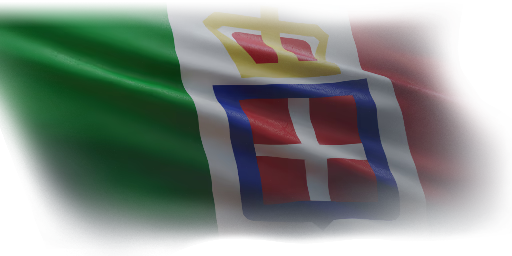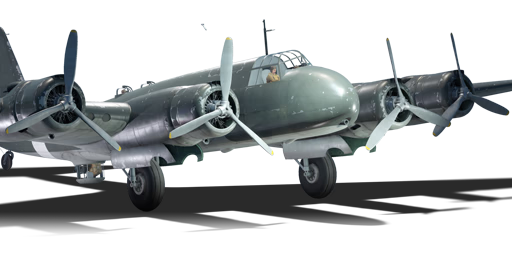




The Piaggio P.108A Artgliere (lit. "Gunship") was an unusual variant of the P.108 heavy bomber. Designed in response to a requirement issued in November 1942 to supplement torpedo bombers in anti-shipping duties, the P.108A was armed with a massive 102 mm 102/35 mod.14 cannon (a bored-out version of the proven 90 mm 90/53 mod.41 anti-tank cannon) in its fuselage, one of the largest armaments ever fitted onto an aircraft at that time. To maximize the effectiveness of the gun, the plane was to be fitted with an analog computer to help in calculating the aim, as well as a 12-round autoloader. However, due to the worsened situation of Italy, frequent Allied bombing raids, and the realization that such an aircraft was more expensive than a traditional bomber while its theoretical effectiveness was questionable at best, only one prototype was built and tested before the program was cancelled in September 1943. The sole P.108A would later be captured by the Germans but presumably destroyed in a later bombing raid in 1944.
Introduced in Update 1.69 "Regia Aeronautica" initially as a rank III "strike aircraft", but gradually reduced to a rank I aircraft. The P.108A serie 2 is similar to the normal P.108s, but with a 102 mm anti-shipping gun containing 50 rounds, basically making it an oversized Hs 129 B-3 or PBJ-1H. However, the main reason for the Artgliere to be now pitted frequently against reserve biplanes and early monoplanes rather than being used for tank-busting (or boat killing) duties like the aforementioned planes is due to it being too big, too slow, too sluggish, and too hard to get its gun on target without being hit by any enemies. The 102 mm cannon was intended to be used against large and relatively defenseless target like an average cargo ship, something that the Artgliere will rarely come across outside of Simulator Battles. Managing to hit any ground vehicle with the first shot is considered a miracle, let alone against aircraft. Since the 102 mm is the only "offensive" armament it has, the P.108A is restricted to ground attack role, something that it performed rather poorly.
In an ironic twist, the P.108A is placed at such a low BR that it can be played as a pure gunship and keep true to its official nickname Artgliere, baiting any inexperienced pilots to chase your tail and hope that you can gun them down with your defensive turret. Though be warned; the plane is pretty much a sitting duck against those who know where to attack it.
flaps
flaps
flaps
brake
| Belt | Belt filling | Armor penetration (mm) at a distance: | |||||
|---|---|---|---|---|---|---|---|
| 10 m | 100 m | 500 m | 1000 m | 1500 m | 2000 m | ||
| AP-T/HEI-T | 159 | 157 | 147 | 135 | 124 | 114 | |
| HEI-T | 19 | 18 | 17 | 16 | 14 | 13 | |
| AP-T | 159 | 157 | 147 | 135 | 124 | 114 | |
| Belt | Belt filling | Armor penetration (mm) at a distance: | |||||
|---|---|---|---|---|---|---|---|
| 10 m | 100 m | 500 m | 1000 m | 1500 m | 2000 m | ||
| T/Ball/AP/AP/HEF | 21 | 19 | 12 | 7 | 4 | 2 | |
| AP/AP/AP/API-T | 21 | 19 | 12 | 7 | 4 | 3 | |
| API-T/AP-I | 21 | 19 | 12 | 7 | 4 | 3 | |
| Belt | Belt filling | Armor penetration (mm) at a distance: | |||||
|---|---|---|---|---|---|---|---|
| 10 m | 100 m | 500 m | 1000 m | 1500 m | 2000 m | ||
| T/Ball/AP/AP/HEF | 21 | 19 | 12 | 7 | 4 | 2 | |
| AP/AP/AP/API-T | 21 | 19 | 12 | 7 | 4 | 3 | |
| API-T/AP-I | 21 | 19 | 12 | 7 | 4 | 3 | |
| Belt | Belt filling | Armor penetration (mm) at a distance: | |||||
|---|---|---|---|---|---|---|---|
| 10 m | 100 m | 500 m | 1000 m | 1500 m | 2000 m | ||
| T/Ball/Ball/AP-I/AP | 13 | 12 | 7 | 3 | 2 | 0 | |
| T/AP/AP/AP | 13 | 12 | 7 | 3 | 2 | 0 | |
| T/AP-I/AP-I/AP-I | 13 | 12 | 7 | 3 | 2 | 0 | |












Flight performance | |
|---|---|
Survivability |
|---|
Weaponry | |
|---|---|